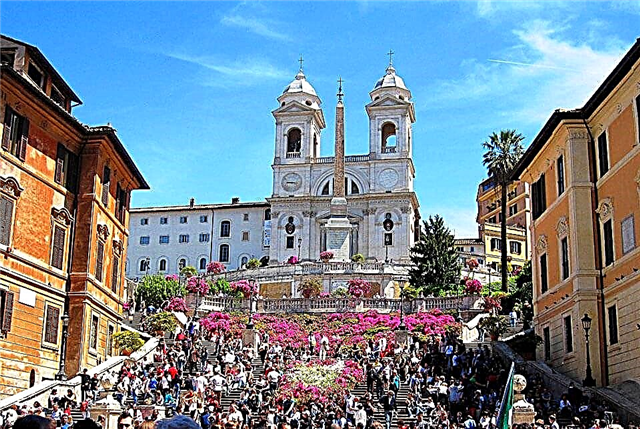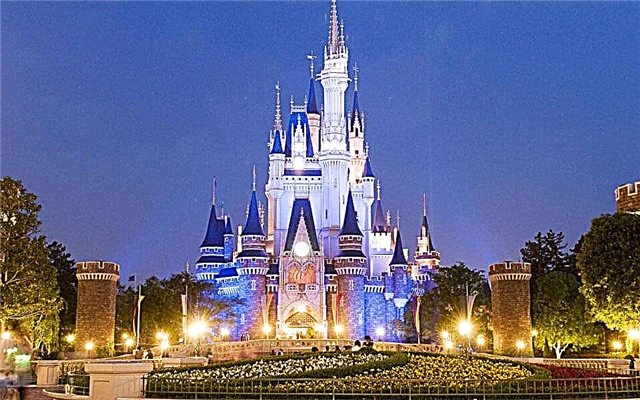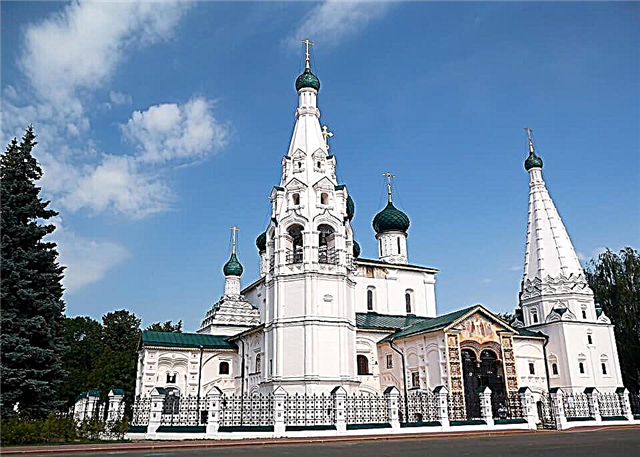Address: Russia, Moscow, Andropova Avenue, 39
Start of construction: 1528 year
Completion of construction: 1770 year
Main attractions: The Tsar's Palace, the Church of the Ascension of the Lord, the Church of the Kazan Icon of the Mother of God, the bell tower of the Church of St. George the Victorious, the Church of the Beheading of John the Baptist, Vodovzvodnaya Tower, Front Gate, Colonel's Chambers, Palace Pavilion, House of Peter I
Coordinates: 55 ° 40'05.4 "N 37 ° 40'08.7" E
Content:
Short description
The Kolomenskoye estate is one of the best historical, architectural and natural monuments of modern Moscow. It is located in the south of the capital and occupies about 400 hectares of land. In ancient times, this area was a village called "Kolomenskoye". It was founded by settlers fleeing the Mongol-Tatar troops led by Batu.

Manor Kolomenskoye from a bird's eye view
The first mention of the village is found in the chronicles of the XIV century - at that time it was a princely property, served as a summer estate and was passed down from generation to generation. According to some sources, the ancient settlement was the place where Russian troops returned after the Battle of Kulikovo. Here the army of the Russian Tsar Peter I also gathered on campaigns.
In 1532, a stone Church of the Ascension appeared on the territory of the village. It did not differ in scale - the shrine served the Russian tsars as a house church. However, the church building was also used as a guard tower. At the moments when the enemy approached the city, a conditional signal was given from it. At night - in the form of a flame, and during the day - a column of smoke. As soon as an alarming sign appeared, the watchmen immediately duplicated it, knowing that it was also visible on the Ivan the Great Bell Tower located on the territory of the Kremlin. Today the temple is active. It contains the icon of the Sovereign Mother of God, revered by believers.

Church of the Ascension
In the neighborhood of the church, there are several other monuments dating back to a later period. These are the St. George Bell Tower (16th century), the Vodovzvodnaya Tower (17th century) and the "brainchild" of the architect E.D. Tyurin - Hunting Pavilion (1825).
The main part of the Kolomenskoye estate is represented by the Tsar's courtyard, which is surrounded by protective walls. To enter the estate, the Front gate (through which the sovereign entered the estate) and the Rear gate are provided. Nearby you can see the Prikaznye and Colonel's Chambers, as well as the Sytny Dvor, where they prepared food for the tsar's table. Today their premises are occupied by the exposition of the state museum.

Church of the Beheading of John the Baptist
The Tsar's Palace is the main attraction of the Kolomenskoye estate
In the 17th century, the royal palace appeared on the territory of the estate. It had up to 270 rooms for various purposes, and the number of windows reached three thousand. Tsar Alexei Mikhailovich was very fond of Kolomenskoye and constantly reconstructed it.
In this place, he was engaged in falconry, spent his leisure time, and also arranged official receptions. All construction work on the construction of the palace was carried out by the best master carpenters of their time. Upon completion of the construction, the new luxurious building was consecrated by Patriarch Pitirim.

The palace of Tsar Alexei Mikhailovich, reconstructed in 2010
The premises of the palace were divided into two parts - male and female. The male one began with a ceremonial entrance and included the palace of the sovereign and his sons. In the women's quarters were the palace of the queen and her daughters. The majestic palace consisted of 26 towers of different heights. The lowest were two-story, and the highest had four stories.
The palace complex was organically complemented by chambers, household yards, guardhouses and the Kazan temple. All buildings were surrounded by gardens. The facades with carved platbands made the palace elegant, and therefore it was often spoken of as a "fairy tale palace" and the eighth wonder of the world.

Temple of the Kazan Icon of the Mother of God
However, time passed, and there was no longer a need for a palace near Moscow. St. Petersburg became the capital, and the village near Moscow fell into decay. The dilapidated building was dismantled, and in 1767 a new palace appeared opposite the Ascension Church. Its lower floors were stone, while the upper two were made of wood. During the reign of the Russian Tsar Nicholas I, the new palace was reconstructed by the architect E.D. Tyurin. By the end of the 19th century, the roofs of the palace building were repaired and the dilapidated structures were replaced.
Features of the manor park
The manor park is rich in historical monuments brought here from different parts of the country. This is the Polovtsian Baba - a stone mound monument, the construction of which dates back to the late 11th - early 12th centuries. At first glance, it may seem that the woman is a female sculpture, but this is not so. In the Turkic languages, the word "baba" means "father".

Church of St. George the Victorious
The Borisov stone made of granite is no less interesting. This border mark from the princely possessions dates back to the 12th century. There is an inscription on the granite stone - an appeal to God with a request for the safety of servant Boris.
The park area has become a haven for the exhibits of the Museum of Wooden Architecture, which has collected several ancient unique buildings. These are the mead brewery, the Holy Gates from the Nikolo-Korelskaya monastery and the prison tower from Bratsk. In the 1930s, the House of Tsar Peter I "moved" here, which used to stand near the mouth of the Northern Dvina River.

Vodovzvodnaya tower
Behind a large ravine dividing the park in two, there is the Church of the Beheading of John the Baptist, built in honor of the birth of his son by decree of Tsar John IV the Terrible. There is also an apple orchard, the beauty of which is especially revealed in May, during the flowering of trees, as well as during the harvest.
In ancient times, the village was famous for several berry and orchards. But today only three gardens remain on its territory - Kazan, Voznesensky and Dyakovsky. Despite their considerable age, all trees bloom well and bear fruit every year. Behind the gardens there are wooden houses that remain from the village of Dyakovo. Next to it, archaeologists have found valuable artifacts belonging to the Finno-Ugric culture. The village, also called the "Dyakov settlement", is the oldest settlement in Muscovy. The bank of the river of the same name in this place is high, and it offers a magnificent view of the surroundings.

Front gate
There are ethnographic exhibitions in the park. These are the premises of a stable and a smithy, the territory of a pharmaceutical garden and an apiary, as well as a water mill on the Zhuzha River.
How the estate became a museum-reserve
The idea of turning the estate complex into a museum-reserve belongs to P.D. Baranovsky, who since 1923 served as its director. A few years later, the museum was replenished with a mead brewery, the Mokhovaya tower, the Petrovsky House and the gates from the Nikolo-Korelskaya monastery. In 1960, a prison tower was brought here from the Siberian Bratsk. So, gradually the museum complex has collected some of the best wooden buildings made by Russian craftsmen.

Rear gate
Kolomenskoye received the status of a museum-reserve in 1971. On its territory are collected rare manuscripts, books, objects of the Neolithic era, as well as some values from already defunct temples. A rich collection of ceramics is also kept here.
The Kadochka oak groves and springs, which bear the names of Christian saints - the Twelve Apostles, St. George the Victorious and St. Nicholas the Wonderworker - have the status of natural monuments. But the boulders, which are called the "Head of the Horse" and "The Maiden's Stone", are especially attractive to visitors.

Palace (Hunting) Pavilion
Today the former manor house is one of the historical gems of the capital, and the Church of the Ascension of the Lord is included in the UNESCO list of World Heritage Sites. You can get acquainted with the museum expositions on ave.Andropov, 39.











